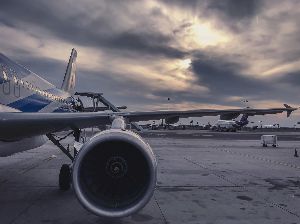Interstate Domestic Air Freight
Fast, secure and dependable air cargo across Australia
Interstate Domestic Air Freight: Australia’s Industrial Continuity Layer


Author : Tyson Shipp
Domestic Air Freight Specialist contributing to hhiexpo.com.au. Tyson writes practical editorial insights to help Australian businesses move urgent shipments safely and on time across interstate air routes.
Australia is a geography problem disguised as a country. Its vast distances, dispersed population centres, and widely distributed industrial assets create challenges few other nations face. Unlike Europe, where capital cities are clustered and transport corridors are dense, Australian logistics must navigate hundreds, even thousands, of kilometres of sparse infrastructure. Ports, airports, and resource hubs are scattered across an immense landmass. Western Australia funnels freight differently to Queensland. Victoria has its own demand pulses. Sydney’s air freight patterns follow a calendar of corporate and consumer rhythms.
When you look closely, interstate domestic air freight is not about “fast delivery” in the e-commerce sense — it is how Australia solves the problem of distance without collapsing its supply chains. This is the invisible layer that protects uptime, operational resilience, and the flow of capital-intensive industries.
Air Freight as Continuity, Not Speed
Most outsiders still assume air freight equals express delivery. That is amateur thinking. In reality, air freight in industrial, mining, MRO, and medical contexts is uptime protection. Procurement chiefs, MRO managers, and inventory planners do not measure the cost of the flight against their budgets — they measure it against the potential cost of a production halt, a mining site shutdown, or a medical cancellation.
In heavy industry, a $200 or $600 air uplift is trivial compared to the financial exposure of downtime. A single delayed part in a mining operation or a maintenance bay can erase hundreds of thousands — sometimes millions — in revenue, export value, or operational throughput. Air freight is not a line item. It is continuity insurance.
The Domestic Air Network is Not a Single System
Australia’s domestic air network is not one organism. It is a mosaic of micro-theatres, each with its own behaviours, incentives, and constraints. Geography, commodity class, seasonal pressures, and airport-specific logic create a complex set of dynamics.
Sydney and Melbourne operate like high-frequency shuttles. Capacity is dense, schedules predictable, and belly-space pricing is influenced more by competition and revenue science than commodity urgency.
Perth functions as a frontier gateway. Cargo flows are dictated by remote mining supply lines, offshore energy, and contingency stock, where air freight mitigates extreme geographic and operational risk.
Brisbane is sensitive to agricultural cycles, with prices fluctuating as exporters chase market windows.
Darwin acts as a forward operating base influenced by resource flows and defense posture.
Adelaide aligns with industrial and defense contracts, where production calendars dictate schedules more than consumer demand.
These variations explain why cut-off times differ, after-hours rules differ, priority loading differs, and certification/documentation acceptance differs. Every airport micro-theatre operates under its own physics.
The True Economics of Domestic Air Freight
Interstate domestic air freight pricing is driven by volumetric weight, chargeable weight, aircraft type, daily capacity, and route flow stability. CFOs often get this wrong: the air invoice is visible, tangible, and gets scrutinized. But the true financial risk is the loss of output if the critical part doesn’t arrive.
Industrial continuity thinking replaces “shipping cost” with “loss-of-output cost.” In sectors like mining, aerospace maintenance, marine engineering, and energy, an uplift of $400 can prevent $150,000 or more in hourly losses. A $600 air move might avoid millions of dollars in lost throughput. These numbers reveal why air freight is not luxury or convenience — it is a mathematical hedge against operational risk.
Chargeable Weight and Strategic Modelling
Airlines price by the greater of actual weight or volumetric (chargeable) weight. This transforms small, low-density items into critical planning considerations. Industrial operators must model cubic efficiency per unit load, density ratios, and aircraft utilization. Decisions are never emotional. They are mathematical. Interstate domestic air freight is optimized around these variables to protect throughput, not to reduce a line item.
Same-Day vs Next-Available-Flight Logic
Operators differentiate between premium same-day actions and next-available-flight throughput actions. Same-day is triggered when downtime is active or imminent. Next-available-flight is used when risk exists but has not yet crystallized. This decision tree ensures capital is protected without unnecessary expenditure.
When Air Freight is Overkill
Even industrial operators know that air is not always required. Non-critical, low-density, or non-urgent items may move more efficiently by road or rail. The distinction is always about operational risk, not cost. Using air unnecessarily is a sign of impatience, not strategy.
Where Air Freight Outperforms Road and Rail
Air freight becomes dominant where time sensitivity, operational risk, and capital exposure intersect. This includes:
Remote or frontier locations where road/rail are unreliable
High-value, low-volume cargo where downtime costs dwarf uplift cost
Maintenance windows with no float for delay
Situations where road/rail disruption risk is higher than air risk
Air is a time hedge. Road is a capacity carrier. Rail is an efficiency engine. Industrial leaders deploy each mode based on the economic reality of uptime and throughput, not arbitrary budgets.
Corridor-Level Economics
Across corridors, behaviours differ:
Sydney–Melbourne: high-frequency shuttle economics
Perth: frontier gateway logic for mining and energy
Brisbane: seasonal and agricultural influence
Darwin: forward-operating base logic
Adelaide: industrial and defense timing
These corridors illustrate how micro-theatres define strategy.
Closing Thoughts
Australia’s interstate domestic air freight network is not a convenience. It is a strategic backbone of industrial continuity. It is the invisible insurance layer, the mathematical hedge, and the capital protection mechanism that underpins critical sectors. Understanding it requires more than spreadsheet analysis — it requires comprehension of geography, operational physics, throughput economics, and the cost of downtime.
This is why air freight decisions in Australia are rarely about speed or tariff comparison. They are about protecting production, protecting revenue, and safeguarding the engine of industry.








